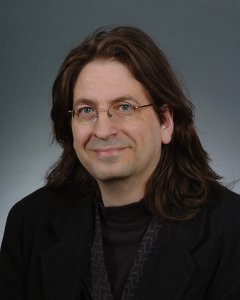
Keynote Speaker
Visualization Challenges at the Intersection
of Petascale Computing and Biological Science
Rick
Stevens, Argonne National Laboratory/The University of Chicago
Abstract
 Since the beginning of the computer era scientists have
dreamed about using the power of computation to develop a predictive
understanding (a computational "theory") that could help
explain the structure, function, and evolution of biological
systems. Early attempts to develop computer models and the associated
theory of biological systems were limited by our lack of a detailed
molecular-level understanding of the mechanisms involved in even the
most basic functions of growth, development, and genetic
inheritance. Later, as modern molecular and structural biology cracked
the genetic code and biochemists filled in the chemical details of
metabolism, available computer power became the bottleneck in
extending our understanding towards prediction. Today new classes of
computers provide the necessary power and the recent dramatic advances
in the availability of biological data yields information ranging from
the DNA sequences of over 500 organisms to detailed snapshots of
cellular machinery in action.
Since the beginning of the computer era scientists have
dreamed about using the power of computation to develop a predictive
understanding (a computational "theory") that could help
explain the structure, function, and evolution of biological
systems. Early attempts to develop computer models and the associated
theory of biological systems were limited by our lack of a detailed
molecular-level understanding of the mechanisms involved in even the
most basic functions of growth, development, and genetic
inheritance. Later, as modern molecular and structural biology cracked
the genetic code and biochemists filled in the chemical details of
metabolism, available computer power became the bottleneck in
extending our understanding towards prediction. Today new classes of
computers provide the necessary power and the recent dramatic advances
in the availability of biological data yields information ranging from
the DNA sequences of over 500 organisms to detailed snapshots of
cellular machinery in action.
In this talk I will propose a short list of open visualization problems from large-scale computational and theoretical biology. The complexity of biological systems are now being attacked with a degree of confidence never before seen as the confluence of high-throughput experimental methods, advances in bioinformatics databases, Petascale computing platforms and the emergence of systems biology provides a new framework for understanding. Many of the biological systems are now being attacked at the whole genome level, generating data for each gene or gene product under various conditions. These datasets are not large by physical science standards but they are complex and they are noisy, making them a challenge to interpret. Often interpretation itself requires comparative analysis with dozens or hundreds of other genomes and the knowledge associated with those organisms' genes, proteins, networks, physiology and phenotypes. The need to visualize data in a comparative framework results in a new set of challenging visualization and data analysis problems. I will also discuss how the twin revolutions in computation and biological science are combining to develop theoretical biology and will discuss the enormous impact this will have on science, medicine, and engineering. However to maximize this impact will require the solution to many interesting and challenging visualization problems.
Bio
Rick Stevens is associate laboratory director for Computing and Life Sciences. He heads Argonne's advanced computing initiative targeting the development of petaflop/s computing systems. He is also a professor of computer science at the University of Chicago and is senior fellow of the Argonne/University of Chicago Computation Institute, a multidisciplinary institute aimed at connecting computing to all areas of inquiry at the University and the Laboratory. In addition, he heads the Argonne/Chicago Futures Lab, a research group he started in 1994 to investigate problems in large-scale scientific visualization and advanced collaboration environments (his group in the Futures Lab has developed the widely deployed Access Grid collaboration system).
Prof. Stevens is interested in the development of innovative tools and
techniques that enable computational scientists to solve important
large-scale problems effectively on advanced scientific
computers. Specifically, his research focuses on three principal
areas: advanced collaboration and visualization environments,
high-performance computer architectures (including Grids), and
computational problems in the life sciences, most recently the
computational problems arising in systems biology. In addition to his
research work, Prof. Stevens teaches courses on computer architecture,
collaboration technology, virtual reality, parallel computing, and
computational science.
![]()
 Week-at-a-Glance
Week-at-a-Glance